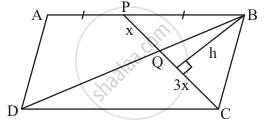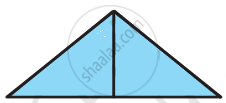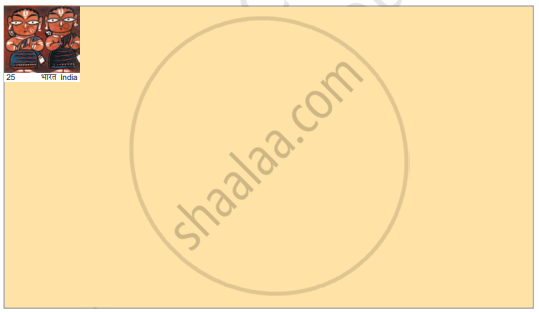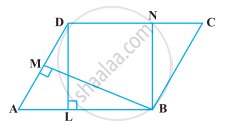Advertisements
Advertisements
प्रश्न
ABCD is a parallelogram. P is the mid-point of AB. BD and CP intersect at Q such that CQ: QP = 3.1. If ar (ΔPBQ) = 10cm2, find the area of parallelogram ABCD.
उत्तर

Proof:
Let, CQ = 3x & PQ = x
ar (ΔPBQ) = 10cm2 ...(1)
We know that, Area of Δ = ½ × Base × Height
ar (∆PBQ) = ½ × PQ × BQ
10 = ½ × x × h
[Let BQ = h ]
10 × 2 = xh
xh = 20 ...(2)
ar (∆BQC) = ½ × QC × BQ
ar (∆BQC) = ½ × 3(x × h)
ar (∆BQC) = ½ × 3 × 20
[From eq 2]
ar (∆BQC) = 3 × 10
ar (∆BQC) = 30 cm² ...(3)
Now,
ar (∆PCB) = ar (∆PBQ) + ar (∆BQC)
ar (∆PCB) = 10 + 30
[From eq 1 & 3]
ar (∆PCB) = 40 cm²
½ × PB × BC = 40 cm²
PB × BC = (40 × 2) cm²
PB × BC = 80 cm² ...(4)
Now, area of parallelogram = Base × Height
ar (|| gm ABCD) = AB × BC
ar (|| gm ABCD) = 2 PB × BC
[AB = 2 BP , P is the mid point of AB]
Area (ABCD) = 2 × 80
[From eq 4]
ar (ABCD) = 160 cm²
Hence, the area of parallelogram ABCD is 160 cm².
APPEARS IN
संबंधित प्रश्न
Two parallelograms are on the same base and between the same parallels. The ratio of their areas is
A, B, C, D are mid-points of sides of parallelogram PQRS. If ar (PQRS) = 36 cm2, then ar (ABCD) =
Diagonal AC and BD of trapezium ABCD, in which AB || DC, intersect each other at O. The triangle which is equal in area of ΔAOD is
The medians of a triangle ABC intersect each other at point G. If one of its medians is AD,
prove that:
(i) Area ( ΔABD ) = 3 x Area ( ΔBGD )
(ii) Area ( ΔACD ) = 3 x Area ( ΔCGD )
(iii) Area ( ΔBGC ) = `1/3` x Area ( ΔABC ).
Find the area of a square, whose side is: 4.1 cm.
Is the area of the blue shape more than the area of the yellow shape? Why?


Altogether how many squares can be arranged on it?
This stamp has an area of 4 square cm. Guess how many such stamps will cover this big rectangle.

In the following figure, the area of parallelogram ABCD is ______.

Whose footprint is larger - yours or your friend’s?
